
First Lisburn Presbyterian Church
 |
|
First Lisburn
Presbyterian Church, built in 1768; enlarged and remodelled in 1873 and 1970. |
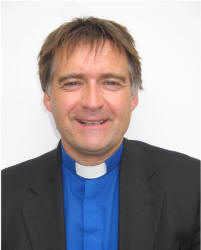 |
|
|
| Rev. John Brackenridge
Minister |
Rev. Dr. Gordon Gray
Minister Emeritus |
Evelyn Whyte Deaconess |
Lisburn City Centre.
Minister: Rev. John Brackenridge
Telephone: 9267 4871
Minister Emeritus: Rev. Dr. Gordon Gray
Deaconess: Evelyn Whyte
Hilary Ferguson Co-ordinator of Youth Ministry
Sunday services:
Church on Sunday: Congregation meets for worship at 11.00am
All age worship: Last Sunday in the month
Worship first: First Sunday in the month at 6.30pm
During July and August we join with some neighbouring churches for Epilogue Services at 8.00pm.
Church Website: www.firstlisburn.org
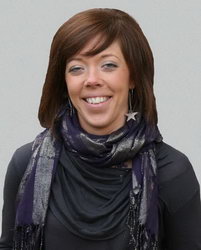 |
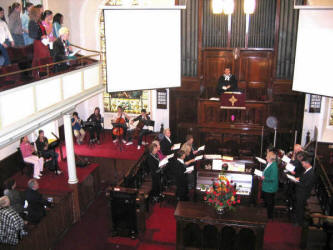 |
| Hilary Ferguson Co-ordinator of Youth Ministry |
The Rev. John Brackenridge - Minister of First Lisburn, Tom Whyte - Organist, Church Choir and a group of musicians (including three of the minister’s family) pictured during morning service at this beautiful Lisburn City Centre Presbyterian Church. |
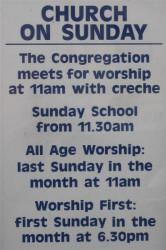 |
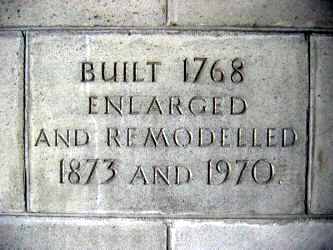 |
| First Lisburn Presbyterian Church Noticeboard | The stone tablet erected in the porch of First Lisburn Presbyterian Church. |
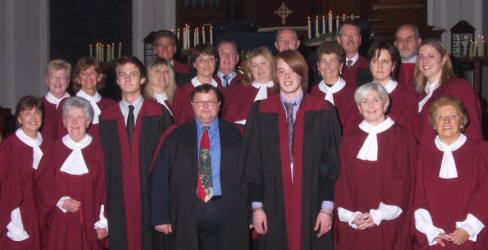 |
| Tom Whyte (Director of Music) and members of First Lisburn Church Choir pictured at the service of Nine Lessons and Carols by Candlelight at First Lisburn Presbyterian Church on Christmas Eve - 2006. |
HISTORY
The first minister of this congregation cannot be ascertained. At a meeting of Presbytery held at Ballyclare on 5th Apr. 1687, Messrs. William Livingston and John McKneight appeared as commissioners from Lisburn, and sought supply of ordained ministers “in order to their being planted with a Gospel minister”. In the November following the people presented a call to Mr. Alexander McCracken who had been licensed by the Presbytery in 1684, and who was ordained to the pastoral charge of the congregation on 3rd July 1688. Rev. Patrick Adair of Belfast presided on the occasion and preached from 1 Cor. iv. 1,2. Mr. McCracken had the promise of £40 yearly of stipend. In 1707 the town of Lisburn was destroyed by a great fire, which consumed both the Episcopal Church and the Presbyterian Meeting-house, then located at the south end of Bow Street. The fire broke out on Sunday, 20th April, a little before twelve o'clock. The Meeting-house was rebuilt on the present site at Market Square at an expense of about £400. The edifice destroyed was valued at £500.
Mr. McCracken had scruples about the oath of abjuration, which was understood to imply that the Pretender was not the son of James II, and was, in consequence of his refusal to take it, more than once brought into trouble. He was a loyal subject and a staunch supporter of the House of Hanover, but he objected to some parts of the phraseology of the oath, and the High Church party most ungenerously took advantage of his scrupulosity to give him annoyance. He died in Nov. 1730 and was succeeded by Mr. Gilbert Kennedy (lic. Armagh) who was ordained to the pastoral charge on 7th June 1732. Harmony did not prevail in the congregation and in 1733 Mr. Kennedy removed to Killyleagh. The contention continued and involved the General Synod on numerous occasions before Mr. Kennedy was succeeded as minister of Lisburn by Mr. William Patton of Ervey and Carrickmaclin who was installed here on 7th July 1736.
It was during the ministry of the Rev. William Patton that the Seceders made their appearance in the North of Ireland, and some of their earliest adherants had at one time belonged to the congregation over which he presided. Those who joined the new-corners eventually established the congregation of Hillhall. Mr. Patton removed to Plunket Street congregation, Dublin, in August 1745, and was followed in Lisburn by Mr. Patrick Buchanan (lic. Strabane) who was ordained to the pastoral charge on 29th July 1747. Mr. Buchanan was a Non-subscriber, died on 1st November 1763, and was followed by Mr. James Bryson (lic. Armagh) ordained on 6th June 1764. During Mr. Bryson’s ministry the present meeting-house was built and opened for worship in 1768. A call to Mr. Bryson from 2nd Belfast was accepted by him on 28th July 1774, and he became Moderator of the General Synod in 1778. He was followed by Mr. George Kennedy (lic. Armagh) who had a short reign. He was ordained on 15th February 1775 but died on 5th April 1779.
A distinguished career began when Mr. William Bruce, son of Rev. Samuel Bruce of Wood Street., Dublin, was ordained on 3rd November 1779. First Lisburn had him for three years till he removed to Strand Street, Dublin, in 1782. He later still became minister of 1stBelfast (N.S.), Principal of Royal Academy and a member of the Presbytery of Antrim. He was followed in Lisburn by Rev. Andrew Craig of Moira who was installed here in June 1782. Another Non-subscriber, he supported the Remonstrance presented to the Synod in 1829. He died at Strawberry Hill on 9th June 1833, but had been given an assistant in the person of Rev. James Morgan of Carlow who had been installed on 23rd June 1824. Destined to become one of the leading evangelical figures in the Church, Moderator of General Synod (1831) and of the General Assembly (1846), and Convener of the Foreign Mission 1840-73, Mr. Morgan was called to Fisherwick where he was installed on 4th November 1828.
Mr. Alexander Henderson (lic. Belfast) was the next minister, ordained on 29th June 1829. He resigned on 4th December 1855 when appointed Military Chaplain (1855-68). He died at Warley, Essex, on 23rd July 1868 and was succeeded by Rev. William Edmund Breakey of Loughbrickland, installed on 3rd September 1856. Mr. Breakey died on 6th April 1872 and his successor was Mr. John Lawrence Rentoul (lic. Route), ordained on 17th October 1872. He resigned on 2nd June 1876 when called to Perth, but in the end he declined the call and was installed again in 1stLisburn on 20th December 1876. The present manse was built during his ministry.
After another ten years Mr. Rentoul was called to St. George's congregation, Sunderland, on 22nd June, and was followed here by Mr. John James Carlyle Breakey who was ordained on 11th November 1886. It was during his ministry that many of the stained glass windows were donated. He retired in May 1927 and died on 17th February 1938.
The congregation then called Rev. David Hay of Carlisle Road, Londonderry, who was installed on 16th December 1927. He was awarded a D.D. by the Presbyterian Theological Faculty, Ireland, in 1949, and in 1949 was nominated Moderator Designate of the General Assembly, but owing to ill-health he had to decline the honour. He retired from this charge on 31stAugust 1949 and died on 17th March 1953. He was followed by Rev. William Boyd, minister of Third Armagh congregation. He had also served as Chaplain to the Forces during the 1939/45 War. He was installed here on 27th April 1950. It was during his ministry that the buildings obscuring the Church were demolished and a new Church front added in 1970. Awarded a Doctorate of Divinity by the Presbyterian Theological Faculty, Ireland, in 1967 Dr. Boyd became the first Moderator of the General Assembly to be supplied by the congregation. He retired on 31st December 1972 and was succeeded by the Rev. Robert John Gordon Gray who was installed here on 27th June 1974, after serving as the General Assembly's Youth Secretary and previously as minister of Belvoir Park Church Extension Charge.
On Wednesday 5th August 1981 a car bomb exploded in Market Street, just round the corner from the church, devastating the church and the entire town centre. The total cost of the restoration of church and windows was almost £100,000. The church required further restoration after a bomb in 1989.
The Resurrection Window
 On Sunday 3rd May 1987 the new window was dedicated by the
moderator of the General Assembly, The Right Rev. Professor John
Thompson. It has been designated “The Resurrection Window” and
was commissioned by the Congregational committee. It bears the
following inscription:
On Sunday 3rd May 1987 the new window was dedicated by the
moderator of the General Assembly, The Right Rev. Professor John
Thompson. It has been designated “The Resurrection Window” and
was commissioned by the Congregational committee. It bears the
following inscription:
This window is a memorial of the bomb-blast of 5th August 1981 and the subsequent restoration of our church and halls. It is a tribute to our neighbours in shops and offices and their will to overcome disaster. It is an echo of the motto of this town: "EX IGNE RESURGAM" (I will arise from the fire). It is a witness to our faith in Jesus Christ our Lord.
The “Resurrection Window” constructed from fragments of the old windows which could not otherwise be re-used.
In the centre is the orb of the earth, surrounded by the red of human suffering, injury, sin and sorrow. But overcoming this are startling shafts of light radiating outwards like a great cosmic explosion. This symbolises the Resurrection of our Lord recapitulated in the spirit of the congregation, town and province rising from the ashes of destruction. Around it all are woven palm branches of victory and of peace. Here and there small triangles of light may be seen as splinters of flying glass or the tongues of fire of the Holy Spirit.
Almost all of this new window is constructed from fragments of the old windows which could not otherwise be re-used. It is the congregation’s memorial of a past event and a proclamation of their faith in the victory of righteousness, love and life itself over the powers of darkness and of death.
Dr. Gray retired in March 2001 and is now the Minister Emeritus in First Lisburn. His successor, the Rev. John Brackenridge, previously in Dundrod, was installed in First Lisburn on 28th November 2002.
Matt Craig from Pennsylvania, who was appointed Youth Director in September 2004, left in October 2008 and returned to University to study for a masters degree in education. He was succeeded by Hilary Ferguson, who was appointed Co-ordinator of Youth Ministry and commissioned on Sunday 2nd November 2008.
A full history of the church by W. I. Craig (Published in 1960) is shown on this web site.
Click on: Presbyterianism in Lisburn from the seventeenth century.
Another history of the church by Wm. Richer (Published in 1998) is shown on this web site. Click on: First Lisburn Presbyterian Church 1688 -- 1988.
Brief history as recorded in a book ‘Lisburn’s Rich Church Heritage’ by John Kelly
The congregation was established in the 1680s and the first Meeting House, a plain building with a thatched roof in the Longstone area, valued at £500, was destroyed in the fire of 1707. It is said that King William worshipped in it while his troops were encamped at Blaris. The Meeting House was rebuilt on the present site at Market Square at an expense of about £400. A stone panel at the entrance to the building indicates that it was built in 1768 and enlarged and remodelled in 1873 and 1970. The first manse was built during Mr Rentoul’s ministry and during Mr Breakey’s ministry many of the stained glass windows were installed. The Very Rev Dr William Boyd became Moderator of the General Assembly in 1967. During his ministry the buildings obscuring the church were demolished and a new church front added in 1970. The Rev Gordon Gray was installed in 1974. On 5th August 1981 a car bomb exploded in Market Street, just round the corner from the church, devastating the church and the entire town centre. The total cost of the restoration of church and windows was almost £100,000. A new window, dedicated in 1987 and designated The Resurrection Window was constructed from fragments of the old windows that could not otherwise be re-used. The church required further restoration after a bomb in 1989. Dr Gray, now Minister Emeritus, retired in 2001 and the present minister, the Rev John Brackenridge, formerly minister of Dundrod, was installed on 28th November 2002.
